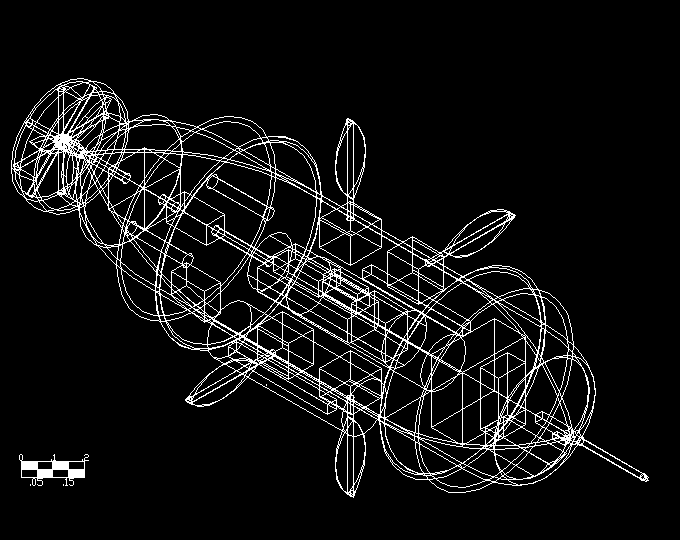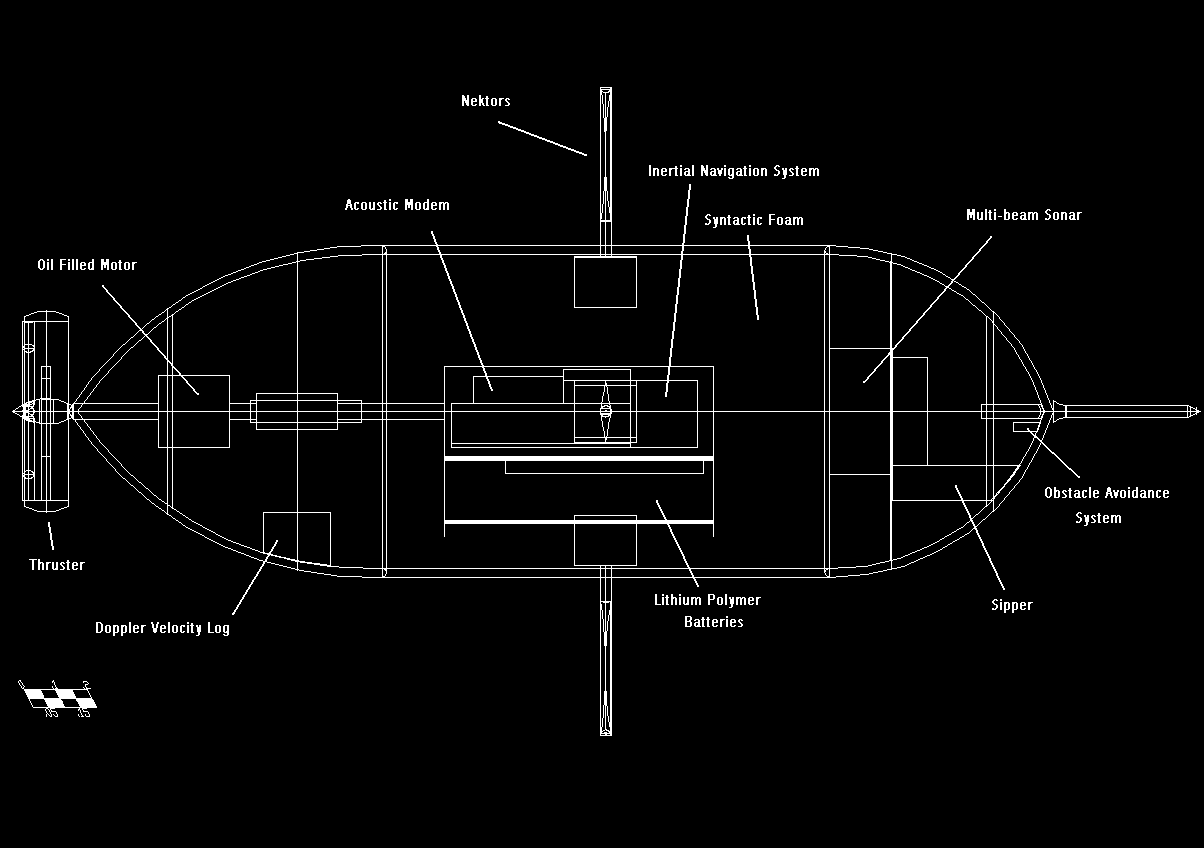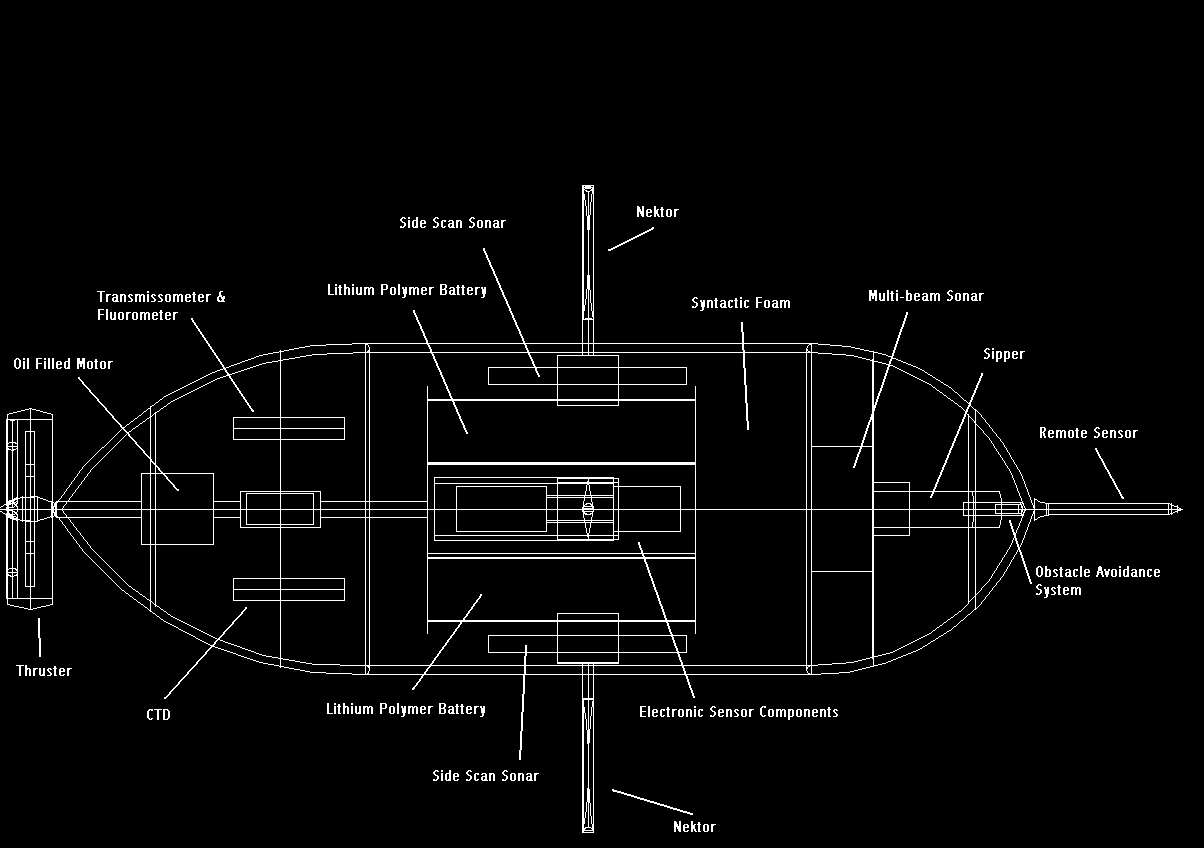Superman AUV

It's a shark! It's a sub! No, it's Superman! Superman is an Autonomous Underwater Vehicle (AUV) that can endure the heat of the vents, has a bottleneck of sensors and mainly acquires data from extreme conditions and especially unexpected events.
When something happens that the scientists did not plan for, he's there to save the day. As an AUV, he will be preprogrammed to handle a range of events autonomously. He is unhampered by a cable or having to serve as tugboat to the manned vehicle. Compared to his AUV brethren the Sisters, Superman can get to the scene faster, would not carry bulky mapping equipment, and would be constructed of an alloy that can withstand the hot and corrosive environment very close to or in the vent and smoker field.
The AUV is capable of collecting images of environment surrounding the vent fields, and of small organisms using the SIPPER tool. As the temperature of th water surrounding vents decreases rapidly with increasing distance from the heat source, Superman has an extension at its front that measures extreme temperatures and pH while keeping the vehicle at a safe distance. Because the hydrothermal vent fields are unpredictable territory, the AUV has myriad of sensors on its exoskeleton that detect extreme temperatures, or salinities, and can direct Superman to a safer environment if he finds himself in hazardous conditions.
Superman uses a revolutionary form of propulsion provided by Nektors (developed by Nekton research company) see Mobility. These nektors give the AUV increased mobility over thruster operated vehicles, and allow it to turn on a dime. This high degree of maneuverability is desirable given that Superman will have to negotiate his way through hazardous conditions.
Technical Specifications
Superman has an exoskeleton which protects the inner pressure housings from extreme temperatures, and optimizes hydrodynamic efficiency. The pressure hull itself consists of high strength syntactic foam within the outer metal layer. This means the metal layer can be thin, and consequently light. The tail and nose cones are flooded, to allow water to reach the sensors located in that region.
Syntactic foam is used to provide enough buoyancy to keep the vehicle neutrally buoyant. The exoskeleton is made of titanium alloy bonded to Ni-base alloy, which is light, and non-corroding in sea-water.
Length: 2.65m
Diameter ( excluding nektors) : 60 cm

Click here to see full sized view of the Superman design

Click here to see full sized side view of the Superman design

Click here to see full sized top view of the Superman design
Payload Sensors
- Sidescan sonar(Klein Technologies)
- Multi-beam sonar
- CTD(seabird electronics)
- Sub-bottom Profiler
- Acoustic Doppler Current Profiler and Velocity Log Argonaut-dvl from Sontek
- Leak Detector
- Obstacle Avoidance Sonar
- Long sensor extension with high range platinum resistance Thermometer( 0 C - 960 C) and pH Meter.
For information on what the sensors are used for see Sensors
Tools
- Tilt pan ccd camera from Deepsea Power and Light
- Two multi -sea light cameras from Deepsea power
For information on the tools see Tools
Navigation unit
Acoustic modemInertial Navigation System
laser gyrometer
Acoustic equipment for LBL navigation.
Pressure Hull
Four aluminium7175-T74 alloy cylindrical canister(with spherical ends) that are 60 cm long and 20 cm in diameter. These house the batteries, the electronic components and the CPU (central processing unit) of the vessel. The CPU is in the PC104 format, allowing interchangeability and upgradeability of components. PC104 also allows operation of the AUV in the familiar C programming language.Energy: Buoyancy and Power calculations
Power
The power consumption of the various sensors on board:(Hotel Load)
- CTD - 5 W
- Sidescan sonar - 8W
- Multi-beam sonar - 10W
- Acoustic Doppler Velocity Log - 3W
- Obstacle avoidance - 4W
- Navigation Systems - 5W
- Electronic components and Intel 80186 cpu( navigation computer available from Sonardyne):- 1 -3W
- Actuators = 5 W
- Fluorometer - 0.3W
- Transmissometer - 0.4 W
- Camera (CCD)- micro-Seacam -6W
- lights - 40W
- Sipper - 20W
Total power consumption of sensors and cpu is approximately = 109 watts
The power of propellers is given by equation: 0.5 * p * A * v^3 * coefficient of drag
(Provided that the AUV is moving with constant velocity)
Coefficient of drag = 0.15
Now range = v * t
Total energy = (Peq + 0.5 * A * p * v^3 * C) * t
Substituting for t from equation (2) we get:
range = Etotal v/ ( Peq + 0.5 *A * p * v^3 * C)
Using differentiation, max range occurs when v = (P/(A * p * Cd))^3
Area = 0.28 meters squared, p = 1 035 kg/m^3
Therefore, optimum velocity = 2.5ms-1 approximately 1 m/s = 5.0 knots
These equations are approximate, not taking into account the variation in density of the water with position, and the variable cross-sectional area of the vehicle. This vehicle will at times be required to move at much higher velocities. But generally, it will move at 2.5 ms-1 to optimize the range.
Energy density of lithium polymer batteries = 250 Wh/l
Total energy = 9.1 Kw
Therefore, range ( from equation 3) = 51km (ideal range.)
Propulsion Load:
Power = 0.5 * p * v^3 * Cd * A = 300 Watts minimum (assuming they are 100 % efficient, which of course os not the case.)
Buoyancy calculations
| Instrument | Weight in Air(kg) | Weight in water |
|---|---|---|
| CTD | 2.7 | 1.4 |
| Sidescan | 1.5 | 0.6 |
| multi-beam | 4 | 1.25 |
| Camera | 0.269 | 0.170 |
| Sub-bottom | 4 | 2.25 |
| ADCP | 9.1 | 2.7 |
| Modem | 11.1 | 3.95 |
| Thruster | 2.7 | 2 |
| Nektors | 1 | 0.34 |
| Navigation and electronics | 1.2 | 1.2 |
| Fluorometer | 1.4 | 0.74 |
| transmissometer | 2.2 | 0.9 |
| Lights | 0.519 | 0.17 |
| Sipper | 2.2 | 0.9 |
| Hull | 93 | 75 |
| Pressure vessels | 12 | 12 |
| Batteries | 70 | 70 |
| Syntactic foam | 120 | -174 |
Therefore = total weight in air = 338.8kg
Total weight in water = 1.5 kg.
It should be 0 kg, so that the vehicle is neutrally buoyant in water. The difference is small, considering that many of the weights are approximate ,and when in doubt I have quoted the maximum values. .
Emergency Measures
This AUV will be working in hazardous conditions. Therefore, it uses its sensor probe, and internal temperature and salinity sensors to measure surrounding conditions. If the temperatures are too high, or the water too corrosive, it immediately attempts to leave the area, at high speed, which the nektors, and rear propeller are capable of. If the conditions are favorable enough to not instantly damage the vehicle, but close enough to the threshold that long term damage could ensue, a timer is set that allows the vehicle to only spend a certain amount of time in the area, after which it departs. Even with theses counter measures in place, it is inevitable that with time the material will begin to corrode, or foul due to the sea-water, and will have to be replaced, hopefully, only once and a while.Superman has a strobe that flashes in case of emergency, and allows the AUV to be visible to any rescue vehicles that search for it.
The leak detecor acts as a preventative device. If the hull is leaking, it emits a warning, and disables the propulsion systems so the auv cannot launch.
The AUV is designed to be slighlty negatively buoyant so that if it should stop working it will sink to the bottom, where it can be picked up by rescue vehicles.
In the unlikely event the vehicle is lost, or its navigation sonars cease to function, it emits a distinctive sonar signal, that will allow it to be located. It also emits an emergency signal via its acoustic modem.
The AUV will be tracked acoustically. An acoustic signal is sent out from the habitat, to pinpoint the position of the AUV, so that it can be followed as it performs its mission. This is crucial, since in many cases AUVs are easily lost to the sea.
RESOURCES 1. Superman Image: http://members.tripod.com/~MitchellBrown/cancom/supermanatthestar.html 2. Superman Designs: created by student Armando Valdes and labeled by Adam Cornelious.

